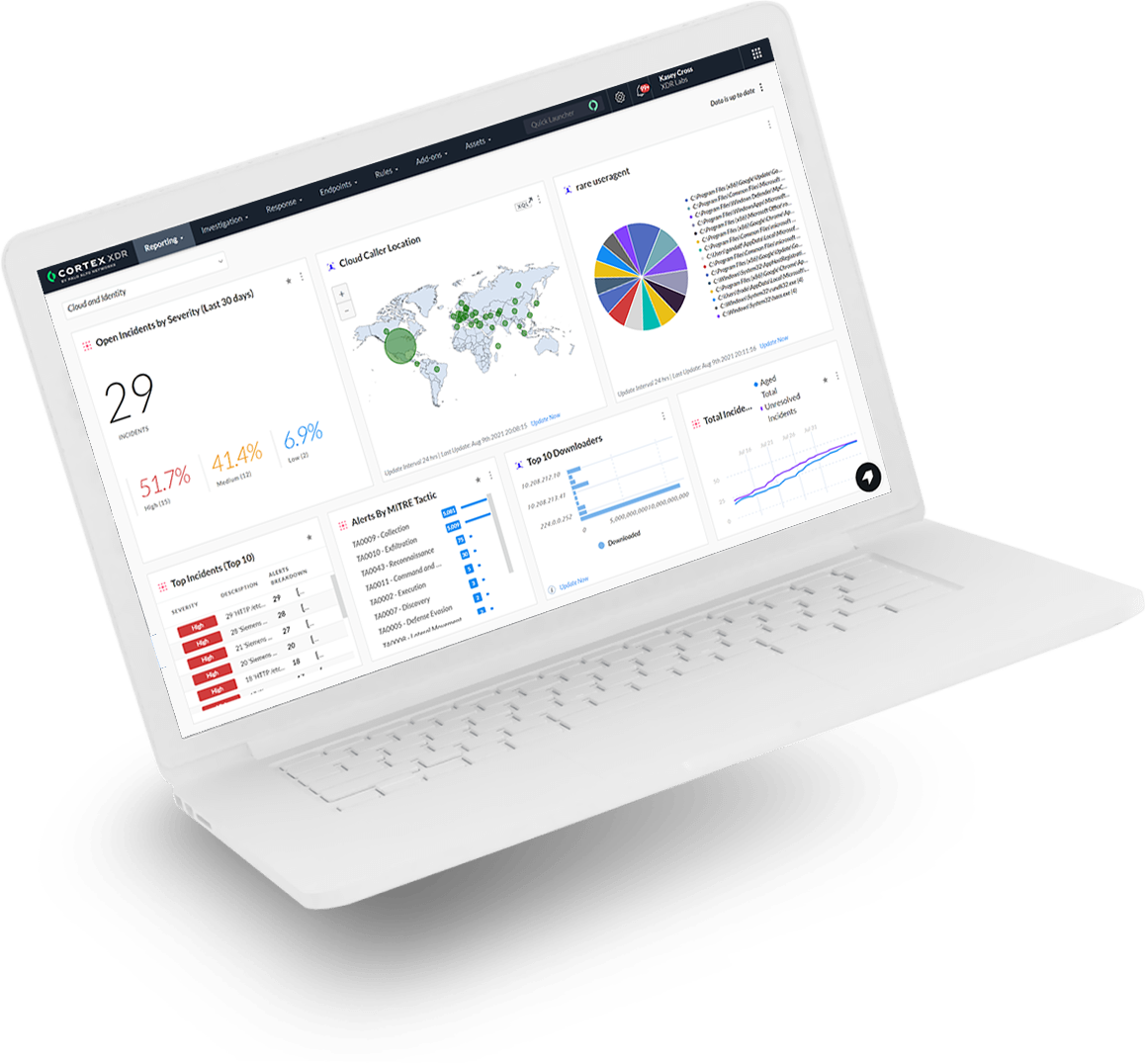Cortex XDR is the better choice to stop modern threats
- ML-powered behavioral analytics across multiple data sources
- An industry-leading malware analysis sandbox to support your threat hunting
- Network visibility that’s integrated into one unified, cloud-based console.

Where does Microsoft fall behind Cortex XDR in tests?
Microsoft Defender XDR doesn’t meet the high visibility and detection requirements needed to defend against today’s nation-state-backed threat actors effectively. In the 2023 MITRE ATT&CK Evaluations (Turla) that pitted EDR products against network implants and backdoors used by Russia’s Federal Security Service, Microsoft posted a 78.3% analytic detection rate, compared to Cortex XDR’s 100.0% analytic detection rate. Microsoft’s detection rate means that 21.7% of substeps taken by these cyber tools failed to result in an endpoint detection, while Cortex XDR detected all substeps.
The speed at which today’s threat actors move through an organization’s compromised network continues to increase. This pace-of-play leaves little time for organizations to change their XDR solution’s configuration to detect a specific threat. Cortex XDR’s 100% detection rate resulted from zero configuration changes, while Microsoft’s 78.3% detection rate contained 39 detections attributed to configuration changes. Cortex XDR achieves these results by:
- Integrating with the WildFire® malware prevention service to detect unknown threats in a cloud analysis environment.
- Leveraging behavioral analytics to profile behavior by tracking more than 1,000 behavior attributes.
- Having behavior analytics, forensics and network visibility natively integrated into Cortex XDR.

Not Enterprise Ready: Microsoft Defender XDR Makes Third-Party Integration Hard
Microsoft Defender XDR excels when an organization needs to integrate, correlate and stitch data, incidents and alerts from Microsoft products. However, to fully integrate data on Microsoft XDR Defender from firewalls, web server logs, cloud logs or IAM products, customers are encouraged to purchase Microsoft Sentinel. Microsoft Sentinel isn’t included in any of their licenses, including 365, E5, E5 Security or E5 Mobility + Security.
Additionally, Microsoft Defender XDR is only partially able to ingest all identity data sources or network fabric data from common identity platforms like Duo or Okta. These limitations create the need for additional product purchases and reconfigurations.
In contrast, the Cortex XDR agent provides full XDR features out of the box. It comes with complete coverage for endpoints across Windows, macOS, Linux, Chrome OS and Android systems and across private, public, hybrid and multi-cloud environments, while Microsoft has more limited functionality on macOS, Linux and legacy Windows. This makes our third-party integration more open and flexible to the needs of growing organizations by:
- Ingesting, mapping and using data from any number of sources that are delivered in standard formats like syslog or HTTP.
- Automatically stitching together data from any source to reveal the root cause and timeline of alerts to identify and quickly stop threats.
- Having Cortex XDR use that data to generate XDR alerts within incidents to quickly scale visibility across an organization.

A Single, Unified View into Threats
Microsoft Defender XDR requires the use of several different products and management consoles in order to achieve the full functionality that Cortex XDR provides. On its own, Microsoft Defender XDR has limited coverage across operating systems. Therefore, it relies on multiple siloed products, each with their own consoles and dashboards to navigate. Investigation time is increased and management is a burden.
Cortex XDR streamlines SecOps by offering a unified platform for detection and response, consolidating alerts and incidents into a single view. SOC analysts can efficiently prevent threats, identify and detect incidents and expedite investigations using a single, automated web-based console. Cortex XDR also includes vulnerability management and identity analytics, which don’t necessitate a partnership or specific connection module. In summary, Cortex XDR:
- Provides one web-based console for detection and response that correlates alerts and incidents into a single view.
- Uses Host Insights to combine vulnerability assessment, application and system visibility, machine learning and Search and Destroy to help analyze threats across all endpoints.
| Products | Microsoft Defender XDR | Cortex XDR |
|---|---|---|
| Superior Detection & Visibility | Lack of visibility and missed detections
| Analytics-based detection drives results
|
|
| |
| Enterprise-Wide Coverage | Incomplete coverage across ecosystem
| Eliminates blind spots
|
|
| |
| ||
| ||
| Single, Unified View of Threats | Too many tools to manage
| One console does it all
|
|
| |
|
| |
| Enterprise Fit | Complex and costly with limited scope
| Tailored to your organization
|
|
|
Cortex XDR consistently outperforms Microsoft Defender XDR in MITRE ATT&CK Evaluations
Cortex XDR delivered 100% threat protection and 100% detection of all attack steps for the second year in a row, with 99.3% of technique detections providing the highest level of detail into attack steps to enable analysts to more quickly and accurately respond to events.





